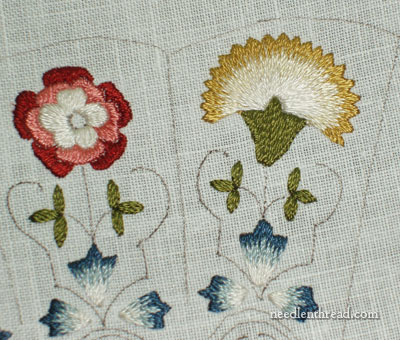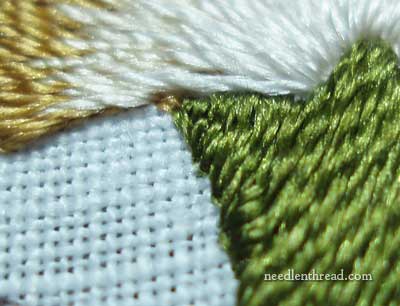Thanks heaps for all your response my Floral Glove dilemma the other day! It’s funny how stitchers more or less think alike – I went through just about every thought process presented in the comments, and I finally settled for Option #3, fixing what I could and then making alterations on the rest as I go.
Here’s the fix. It isn’t perfect, but it’s better than it was.

Though still a tad bit off on the left side, I think the area will cover up fine with the silk purl, which is stitched horizontally over the green base of the flower.

I didn’t bother picking anything out. I simply used a kind of long-and-short stitch technique there, coming up into the threads already there and splitting them, then stitching down over the new line that I had stitched in for the edge of the flower. The new outline took the left edge of the base out a little bit. And the long-and-short stitching, though noticeable up close (and even far away, because of the way the light hits the silk threads), will never be seen, once the area is covered with silk purl.
As for the center flower, I’ll tackle that when I come to it. I think the gold edging around the petals may help hide the defects there.
All in all, I’m happy enough with it to keep going. I’ll have to remember to think before I stitch, though, as I approach a few more trouble spots on the piece.
To answer some of the questions that came up about the fabric the piece is stitched on – it’s a Very Nice linen! Napery Ivory by Legacy, a dower-quality linen that is wonderful to stitch on. I’m already concocting a different project I want to do on the same linen, using the Soie de Paris and worked in whites and off-whites. Mmmmm. It’s fermenting in my brain – and hopefully, I can see it realized this summer some time! But, yes, it’s a nice linen!
Well, what do you think? Is it a good enough fix? Feel free to leave a comment and let me know what you think!
Update (May 23, 2010): After the publishing of this post, there was a misunderstanding about my intention in troubleshooting how to deal with the design transfer as I worked through this project. My purpose was not to damage the reputation of Thistle Threads or to proclaim dissatisfaction over this project. You may read my apology and clarification post for further information if you wish.







I think your fix is fine. All flowers are not perfect in nature, so while it is frustrating, I think it will look great. I would think twice about ordering another project from the place you got this one. I would much rather do my own tracing.
i love your fix, as well as your newsletter. your photos are amazingly clear. as said many times, a picture is worth a thousand words so your tips and tricks are that more valuable. they embolden me as i struggle up that learning curve! trish
Great! I’m glad you didn’t have to pick any of it out. And it looks much, much better…with the silk purl…it will look perfect!
I think your fix will work. When I participated in the Jacket Project, one of her students had just finished this project & brought it in for show & tell–once it’s done, the margins aren’t that obvious–there’s a ton of gold & bling that is far more noticeable.
BTW–I’m also in the class. I’m a late joiner, so I got my kit late and I haven’t started yet. FWIW, my kit doesn’t have the problems yours has. Even if it’s resolved, do contact Trish. I know she outsources the kit assembly, so she’ll want to hear back about defects–she’s very responsive.
I knew you would figure it out and it looks great.
Jersey
Mary, I have been thinking about your problem with this piece off and on since I read your post yesterday. First of all I think the fix is just fine as it will be covered by the purl. If it covers you will feel very clever having improvised a cure and saved the time and materials of having to rework the the piece. Sometimes knowing how to deal with a problem in needlework is very satisfying. I guess the trick is in knowing when you have to rip out and when you can save what you have done. Here is my rule. If I can fix it, and not have it look fixed, I do so. If I need to rip out I do it just before I go to bed. That way the next day I don’t have the nagging problem to think about over and over. The deed is done. Then I can move on and not feel frustrated with the piece.
I do want to say just how much I appreciate your blog. To produce such a well put together published work everyday must be challange. But what a delight to click on the computer every morning and find you there offering inspiration and encouragement for all of us needleworkers!
Nice fix up job. This case will be a treasure once it is finished…..but, that is why you
have a website and the rest of us drool over your projects. Keep up the good work and the good education for the rest of us.
Funny how the smallest changes can make such a different. Straigtening that calxy being a case in point. It looks a lot ‘cleaner’ now.
LOVELYYYYYYYYYYYYYYYYYYYYYYYYYYYY!!!
Hi, Mary–I think your fix is a fine solution. It’s so important to have an arsenal of tricks to enable editing, revising,and correcting a project while it’s underway.
This is certainly a good example of why it’s so important to tranfer designs accurately. The final results depend on it!
Hola, has solucionado tu dilema con mucha gracia. En estos casos yo considero que la primera opción es arreglar y si no sale bien deshacer la parte que no está a mi gusto. Un trabajo de este tipo es para sentirse orgullosa y cuando queda un “ñap” que no gusta, cada vez que ves o enseñas tu trabajo los ojos se te van directos a ese punto, aunque para los demás ni siquiera sea apreciable. Si tú estás contenta con tu trabajo, FELICIDADES, es de lo que se trata. Por mi parte, lo veo estupendamente.
Gracias y un saludo
Hi, Mary
I am glad that you managed to avoid the tedium of picking out the stitching and with the adjustments so far and the purl to come, this piece will look perfect.
Mary, I think this is a great fix!!! What’s best, though, is that all I see at this point is a very beautiful piece that has been beautifully stitched. This may end up being one of your favorites!!!
Carolyn
Right now I am looking at your dilemma as a quilter.
I definitely see the problem you are seeing but, and this is a BIG BUT, no one will notice it when you are finished and it will only bother you if you let it. When I am working on a hand- appliqued and hand-quilted quilt, I see so many faults and areas I wish didn’t exist but once I am finished, the problem areas disappear in the design. Quilters have a saying that nothing is perfect and the religious Amish are said to have put in a mistake on purpose, thinking that anything perfect would make them proud and too God-like.
My feeling is that if you think you can live with it, change it; otherwise, think of it as your way to show your humility and smile everything that you see it.
Thank you for your informative newsletter. I stumbled on to it when I was searching for information about embellishing garments.
You did a great repair job Mary.
Even that tiny adjustment looks much better! Looking good!
Hi Mary
I am new to your blog and live in Australia. I too am a perfectionist but there are times in my embroidery that I have to make adjustments for something going wrong and by the time I am finished the piece no one but me usually knows where my adjustments were. I like a little saying my husband Lionel says “Its not a mistake it is just a design modification” He is an avid woodcarver and he also does wood turning and there are times when he has to make a change to something that did not go the way he wanted it to and in the end the finished work was beautiful.
Keep going your little adjustment looks good!
Berenice
I would like to comment that whenever a student takes the time to contact me about an issue I respond right away and in all circumstances we are able to find a solution to the problem.
I am very, very disappointed that those who may have an issue with the tracing on this project have not contacted me and instead have been using a public online forum to discuss it. Those who have contacted me have had their problem resolved to their liking. I struggle daily to keep up with the flow of email and those who do contact me usually get a response within a few hours.
Tricia
Your stitching is beautiful! I’m glad you were able to fix it so you were happier with it. But for me, the original design did not look bad. I think by its very nature, surface embroidery is very rarely symmetrical, and I find that to be part of its charm. I haven’t started my floral glove yet because I had some other projects to finish, but looking at yours has my fingers itching to start stitching on it!
Lovely work!
I am also doing the glove class. I believe the look of the piece is fine the way it was drawn. It is more “life-like”, as all in nature is not “perfectly symetrical”. Your piece, as you chose to change it, looks good but I don’t feel it was necessary.
I am also doing the glove class. I believe the look of the piece is fine the way it was drawn. It is more “life-like”, as all in nature is not “perfectly symetrical”. Your piece, as you chose to change it, looks good but I don’t feel it was necessary.
Hi there Mary,
I am sure everyone is grateful for the further clarification that you have put on the site…………
………..We all learn and all of us that know you, understand that you are always keen to show us how to achieve good things and there is no ill will in you.
I think it is interesting that it transpires that the piece was supposed to look as it was; again, I believe that we all have a different “eye” and there is nothing wrong in that.
I have to admit, I would have probably amended the piece too…………….anyway, I am sure everything is resolved now.
The biggest gift too is to be able to say sorry if a misunderstanding has arisen; and its amazing how many people struggle with that and you did not.
Kindest regards,